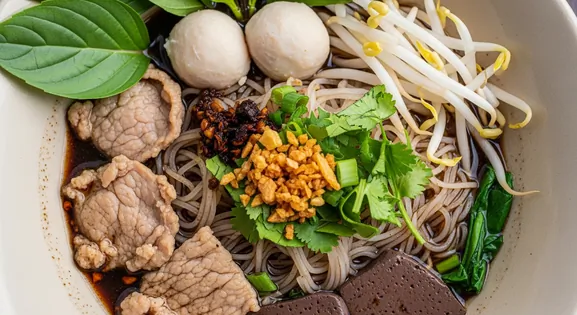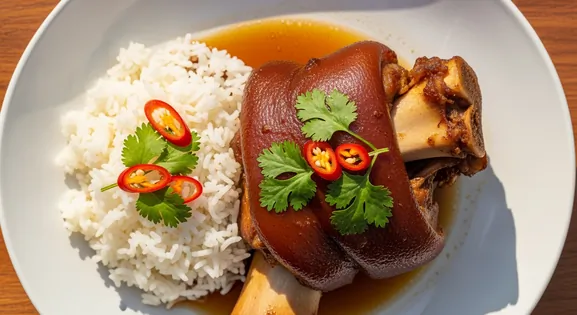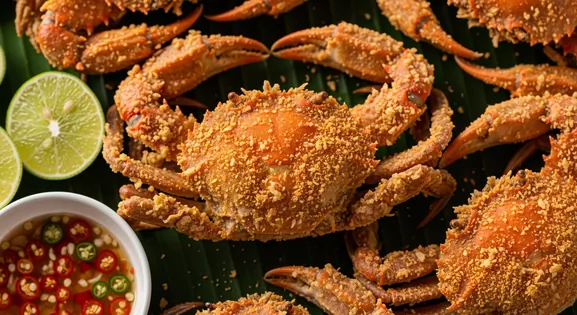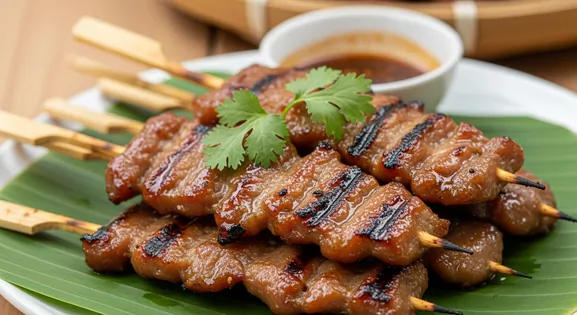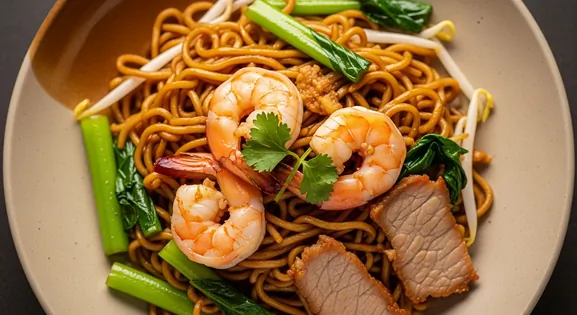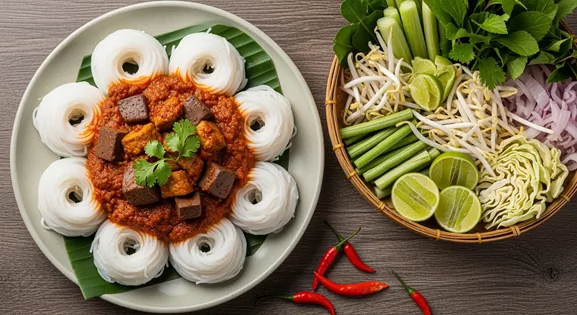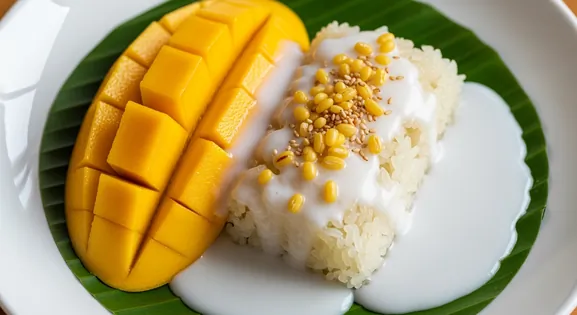Massaman Curry in Thailand: A Complete Food Lover's Guide
แกงมัสมั่น
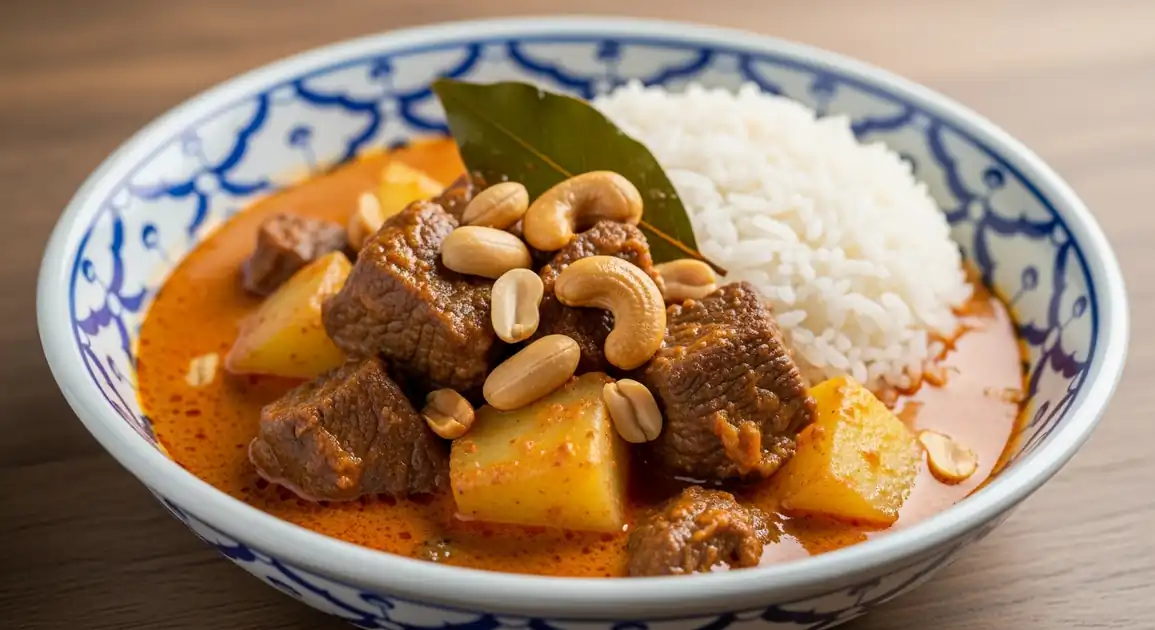
A Culinary Snapshot
Massaman Curry (Gaeng Massaman) is a uniquely flavored Thai curry known for its richness, mild spice level, and aromatic complexity. Originating in Southern Thailand with influences from Malay and Indian cuisines, it features a coconut milk base simmered with meat (often beef or chicken), potatoes, onions, peanuts, and a distinctive spice blend including cardamom, cinnamon, cloves, cumin, and nutmeg, balanced by tamarind, palm sugar, and fish sauce. It's typically served with steamed jasmine rice.
An Authenticity Checklist
What to Look For
-
Served piping hot
Ensures the curry is freshly cooked or properly reheated to kill potential bacteria, especially important for meat dishes.
-
Tender meat consistency
Indicates the meat has been cooked thoroughly for a sufficient time, making it safe and palatable.
-
Visible presence of key ingredients
Look for potatoes, onions, and peanuts/cashews which are characteristic of authentic Massaman.
-
Clean serving area and utensils
Observe the general hygiene of the restaurant or stall, including serving spoons and storage of ingredients.
-
Clear communication about ingredients (allergens)
Staff should be able to answer basic questions about ingredients, especially allergens like peanuts, tree nuts, fish sauce, and shrimp paste.
What to avoid
-
Lukewarm curry
Curry kept at improper temperatures is a breeding ground for bacteria. Insist on hot curry.
-
Meat that looks dry, tough, or old
Suggests improper cooking, reheating, or that the curry has been sitting for too long.
-
Excessive oil separation
While some oil separation is normal and desired ('cracked' coconut cream), a very thick layer of old-looking oil might indicate the curry is old or has been reheated multiple times improperly.
-
Unclean serving spoons or communal pots
Risk of cross-contamination from dirty utensils or customers handling spoons improperly.
-
Vendors unable/unwilling to discuss ingredients
Especially concerning for allergy sufferers. Choose vendors who can provide basic information.
How to Order Massaman Curry
What to Serve with This Dish
Jasmine Rice
staple
Fluffy, fragrant steamed jasmine rice is the essential accompaniment, soaking up the rich curry sauce and balancing its intense flavors.
Roti (Thai-style flatbread)
bread
A soft, slightly crispy pan-fried flatbread, often served alongside Massaman curry, perfect for scooping up the thick, flavorful sauce.
Explore Massaman Curry in Detail: City Guides
Discover where to find the best Massaman Curry and learn local tips in these cities:
History and Origins
Massaman Curry's origins are traced to 17th century Siam (Thailand) through Persian merchants and envoys, possibly influencing the royal court cuisine. The name 'Massaman' is thought to derive from 'Musalman,' an old Persian word for Muslim, highlighting its connection to Muslim traders and Southern Thai Muslim communities. The use of dry spices like cardamom and cinnamon distinguishes it from typical Thai curries and points to foreign influences. It has since become a beloved dish throughout Thailand and internationally recognized.
Crafting the Perfect Dish
Preparation starts with Massaman curry paste, either store-bought or homemade. The paste uniquely includes dry spices like cardamom, cinnamon, cloves, cumin, bay leaves, nutmeg, and mace, blended with typical Thai ingredients like dried chilies, lemongrass, galangal, shallots, garlic, coriander roots/seeds, and shrimp paste. This paste is fried in oil (often rendered coconut cream) until fragrant, then coconut milk is added along with the chosen meat (typically tougher cuts like beef brisket or chicken thighs, simmered until tender). Potatoes, onions, peanuts, fish sauce, tamarind paste, and palm sugar are added later and cooked until the potatoes are soft and the sauce has thickened and balanced flavors.
Key Ingredients of Massaman Curry
Coconut Milk
The creamy base of Massaman curry, providing richness and a slightly sweet flavor. It's simmered to reduce and 'crack' (oil separation), indicating a well-cooked, luxurious sauce.
Quality indicator: Look for fresh, full-fat coconut milk for the best flavor and texture.
Massaman Curry Paste
A complex blend of dried chilies, lemongrass, galangal, shallots, garlic, and unique dry spices like cardamom, cinnamon, cloves, and nutmeg. It defines the curry's distinctive aromatic profile.
Quality indicator: A good paste will be deeply fragrant and well-balanced, not overly spicy or salty.
Potatoes
Typically waxy varieties like small new potatoes or cut larger ones, they absorb the curry's flavors and provide a comforting, starchy texture. They should be tender but not mushy.
Quality indicator: Potatoes should be cooked through but retain their shape, indicating proper simmering.
Local Massaman Curry Variations in Thailand
Massaman Curry with Chicken
A popular version using chicken, often thighs or drumsticks, simmered until tender.
Massaman Curry with Beef
Considered by many to be the classic version, typically using stewing beef cuts simmered slowly.
Massaman Curry with Lamb
Less common but found in some Halal or specialized restaurants, using tender lamb chunks.
Massaman Curry with Vegetables/Tofu
Vegetarian/vegan adaptation using mixed vegetables (like carrots, broccoli, cauliflower) and/or fried or firm tofu instead of meat. Requires ensuring no fish sauce/shrimp paste is used.
Massaman Curry with Duck
A richer variation sometimes found in restaurants, often using roasted duck.
Dietary Information
Dietary Information
Important Note for Travelers: Your safety is our priority. Below are the common allergens associated with the traditional preparation of this dish. However, recipes and ingredients can vary significantly between establishments. Always confirm all ingredients directly with the food vendor before ordering, especially if you have a severe allergy.
Potential Allergens
Dietary Suitability
Frequently Asked Questions about Massaman Curry
What is Massaman Curry?
Massaman Curry (Gaeng Massaman) is a rich, relatively mild Thai curry with Persian and Indian influences. It features coconut milk, meat (commonly beef or chicken), potatoes, onions, peanuts, and a unique spice paste including cardamom, cinnamon, cloves, and cumin, balanced with fish sauce, tamarind paste, and palm sugar.
What does Massaman Curry taste like?
It's savory, creamy, slightly sweet, tangy, and nutty, with fragrant notes from spices like cardamom and cinnamon. Unlike many Thai curries, it's typically mild in chili heat, focusing more on aromatic spice complexity.
Is Massaman Curry safe to eat in Thailand?
Yes, Massaman Curry is generally safe when ordered from reputable restaurants or busy vendors. Ensure it's served hot (properly reheated if pre-made), the meat is tender (indicating thorough cooking), and the establishment looks clean. Be mindful of potential allergens like peanuts and shellfish (shrimp paste).
Is Massaman Curry vegetarian or vegan?
Traditional Massaman Curry is not vegetarian or vegan as it contains meat and usually fish sauce and shrimp paste in the curry paste. However, vegetarian/vegan versions using tofu or vegetables and omitting animal products are increasingly available, especially in tourist areas. Always specify your needs clearly.
Is Massaman Curry gluten-free?
Yes, authentic Massaman Curry is typically gluten-free. Its core ingredients (coconut milk, meat/veg, potatoes, spices, rice) do not contain gluten. However, cross-contamination is possible in kitchens, and soy sauce (containing wheat) might occasionally be added. Confirm if strict GF is needed.
What are the main allergens in Massaman Curry?
Common allergens include PEANUTS (a key ingredient), TREE NUTS (cashews often used), FISH (fish sauce), and SHELLFISH (shrimp paste in curry paste). Soy can sometimes be present. Always inform the vendor/restaurant about allergies.
Expert How-To Guides about Massaman Curry
How to Choose Quality Massaman Curry
Learn to identify the key indicators of a well-made, fresh, and safe Massaman Curry to ensure a delicious and worry-free dining experience.
- Look for rich color and aroma: A deep reddish-brown color and fragrant smell of spices and coconut milk are good signs.
- Check for proper heating: Ensure the curry is served steaming hot, especially if from a pre-made batch ('khao gaeng' stall).
- Observe meat tenderness: The meat (beef/chicken) should be fork-tender, indicating it has been simmered properly.
- Assess vendor/restaurant cleanliness: Choose places that appear clean and hygienic, with well-maintained serving areas.
- Notice key ingredients: Authentic Massaman should visibly contain potatoes, onions, and peanuts/cashews.
- Prefer busy locations: High turnover suggests fresher ingredients and properly cooked food.
Tips for Ordering Massaman Curry
Master the art of ordering Massaman Curry, including how to customize your dish and effectively communicate any dietary needs or preferences.
- Specify your protein: Clearly state if you want chicken ('gai'), beef ('neua'), lamb ('gae'), or tofu ('tao hoo').
- Confirm spice level: While usually mild, you can request 'mai phet' (not spicy) to be sure.
- State allergies clearly: Emphasize any allergies, especially peanuts, tree nuts, fish, or shellfish.
- Request vegetarian/vegan modifications: Ask for 'jay' (vegetarian) or specify 'mai sai nam pla, mai sai gapi' (no fish sauce, no shrimp paste) for vegan.
- Ask about Halal: If needed, inquire 'Mee Halal mai?' (Is it Halal?). Look for certification.
- Order with rice: Massaman is always eaten with plain steamed rice ('khao suay').
Mindful Eating: Massaman Curry Allergens
Understand and navigate the common allergens present in Massaman Curry, ensuring a safe and enjoyable meal, especially for those with sensitivities.
- Peanuts are Key: Be aware that peanuts are a defining ingredient, often whole and in the paste.
- Tree Nuts Possible: Cashews are frequently used as garnish or sometimes within the curry.
- Fish Sauce is Standard: Assume fish sauce ('nam pla') is used unless explicitly requested otherwise.
- Shrimp Paste Likely: Traditional curry pastes ('prik gaeng') almost always contain shrimp paste ('gapi').
- Soy Sauce Uncommon but Possible: While not standard, soy sauce might be used for seasoning in some kitchens.
- Communicate Clearly: Use allergy translation cards or clear phrases ('แพ้ถั่ว' - Phae thua - Allergic to nuts) when ordering.
- When in Doubt, Avoid: If you have severe allergies and cannot confirm ingredients, it's safest to choose another dish.
Our Commitment to Quality
At Tasteplorers, our mission is to provide the most accurate and useful travel information in the world. To achieve this, all content on this site is created through our unique editorial framework. We utilize leading AI research tools, guided by our proprietary prompts, and a multi-stage validation process. This entire system is overseen by our editorial team to ensure everything we publish meets our high standards for accuracy, cultural nuance, and practical value for travelers.
Learn more about our Editorial Process and our Mission.
Countries
Explore regions
Europe
Discover Europe's diverse culinary landscape, from Mediterranean flavors to hearty Alpine fare. Learn to navigate markets, decode menus, and eat like a local.
Latin America & Caribbean
Discover the vibrant cuisines of Latin America & the Caribbean. Our expert guide covers everything from Mexican street food to Peruvian ceviche and market tips.
Oceania
Explore Oceania's diverse food scene. Learn about Polynesian earth ovens, Fijian feasts, and the vibrant café culture of Australia and New Zealand.
Southeast Asia
Explore Southeast Asia's diverse food cultures from Thailand to Vietnam. Get expert tips on navigating spice levels, choosing quality vendors, and understanding the rich traditions of the region.
